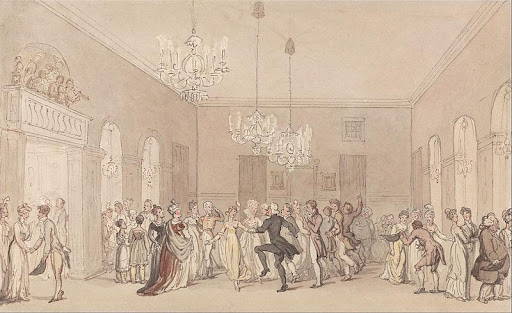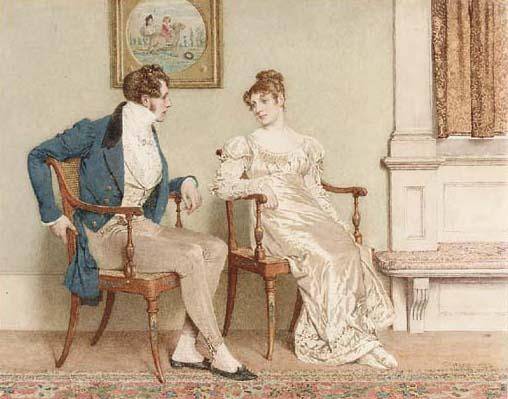Adelaide Magnolia Letter 10 – Regency Balls and Marriage
Balls held a significant role in the social lives of the middle and upper classes in the Regency Era. It was there that positions of power were fought for, standings in society determined, and eligibility in the marriage mart declared. Balls were held both publicly and privately, in public assembly rooms where tickets or vouchers could be purchased, or in private homes where invitations were sent. For a ball to be held in a private home, the host would need to be wealthy in order to provide the space, the staff to see to the guests, the musicians to play, as well as the food to feed their guests since balls traditionally included a sit-down supper.
Balls were considered the most formal occasions, allowing the guests to wear their finest gowns, clothing, jewelry, and finery. Men typically wore knee breeches, a shirt, waistcoat, tail coat, silk stockings, and an intricately tied cravat. White leather gloves, canes, pocket watches, watch fobs, and handkerchiefs were also common accessories worn by gentlemen. Ladies’ dresses varied widely in color and trimmings, but the majority of dresses at that time were of the same empire waist silhouette. Younger, unmarried girls tended to dress in gowns lighter in color and married and older women in darker colors. Ball gowns were always more embellished than everyday dresses, with beads, lace, and even feathers. Women would accessorize with ribbons or flowers in their hair and the truly daring would sport a turban or a headdress festooned with feathers. Long white leather elbow-length gloves would be worn at all times throughout the ball, except when eating. Other accessories included jewelry, fans, and reticules. And of course, when the ball was a masquerade, the dress varied greatly as it did for the characters in our story!
Dressed in their finest, those of marriageable age utilized balls to their advantage. These were one of only a few places courting couples could be alone without having a chaperon right next to them at all times. Though a ballroom was still carefully regulated by etiquette, dancing afforded couples opportunities of physical touch, as well as flirtation and conversation. These were also occasions for intentions to be declared. At a private ball, when an unmarried gentleman asked a young lady to dance more than once, he was indicating a particular interest in her and was setting expectations that he was courting her. With so much that could and would happen at a ball, there is no wonder as to why they were looked forward to with so much anticipation.
*To learn more about Regency Balls, check out the video below. It is a wonderful recreation of a Regency ball and goes into great detail!
“It is always incomprehensible to a man that a woman should ever refuse an offer of marriage. A man always imagines a woman to be ready for anybody who asks her.”
- Emma, by Jane Austen
Traditionally the institution of marriage in England for the middle and upper classes was primarily an arrangement to produce heirs and protect fortunes and estates. Because primogeniture, or the passing of estates to the eldest son, was the law, daughters were expected to “marry well,” or to secure their own financial future through marriage. Once married, a woman surrendered all her property and finances over to her husband. In essence, the husband owned everything, including his wife and any future children.
While this did create an imbalance of power in marriage, during the 18th century and the age of Enlightenment the concept of respect for the individual created the idea of a marriage with mutual respect between partners. In Regency England, the concept of a companionate marriage, or one based on affection and friendship increased in popularity. This was a move from a patriarchal or hierarchal marriage to a marriage where the husband and wife were partners and best friends. The Regency Era became a time where looking for love in marriage was the ideal.
Learn the Vernacular:
Lead the dances: determine the figures, steps and music to be danced
The first set: the opening dances of the ball
Family wing: the area of a large country house or mansion where the family resided
Sources:
https://www.regencyhistory.net/2021/01/how-to-behave-in-regency-ballroom.html
https://www.cdrochester.org/flyers/WomensBallClothing2008.pdf
https://www.cdrochester.org/flyers/MensBallClothing2008.pdf
https://randombitsoffascination.com/2015/03/10/private-regency-ball/
https://asteptogold.com/regency-era-balls-and-dancing-today/
https://thebeaumonde.com/main/courting-and-marriage-in-the-regency-by-cheryl-bolen/
https://byuprideandprejudice.wordpress.com/2014/01/28/courtship-and-marriage-in-the-regency-period/
https://home.heinonline.org/blog/2021/08/a-decent-proposal-marriage-in-regency-england/
https://englishhistoryauthors.blogspot.com/2016/12/after-wedding-comes-marriage-regency.html
https://www.youtube.com/watch?v=X6ZnIOJuhUw


